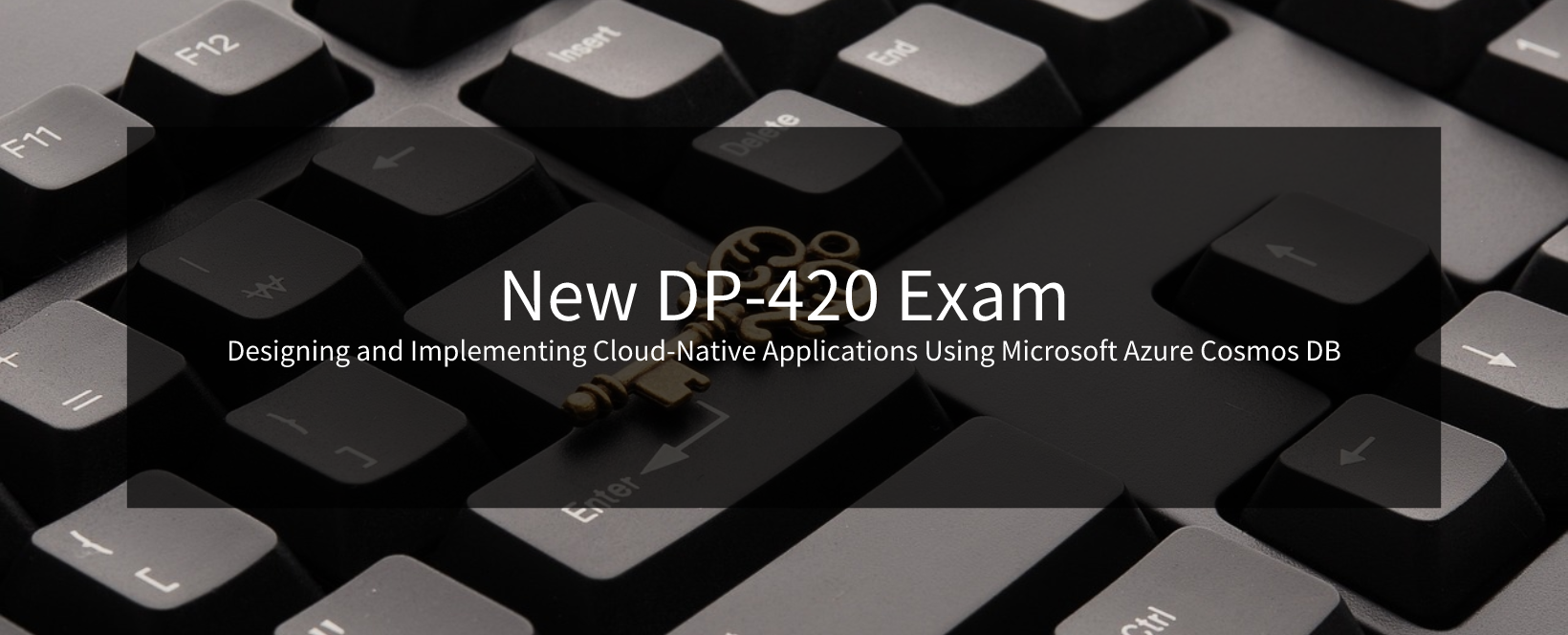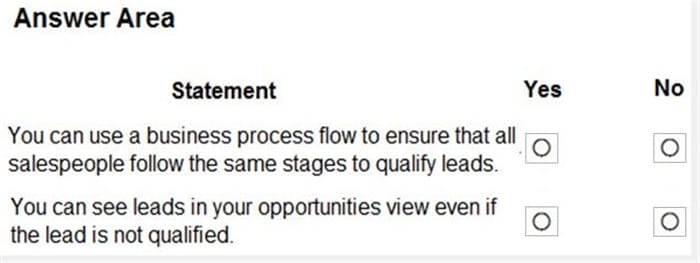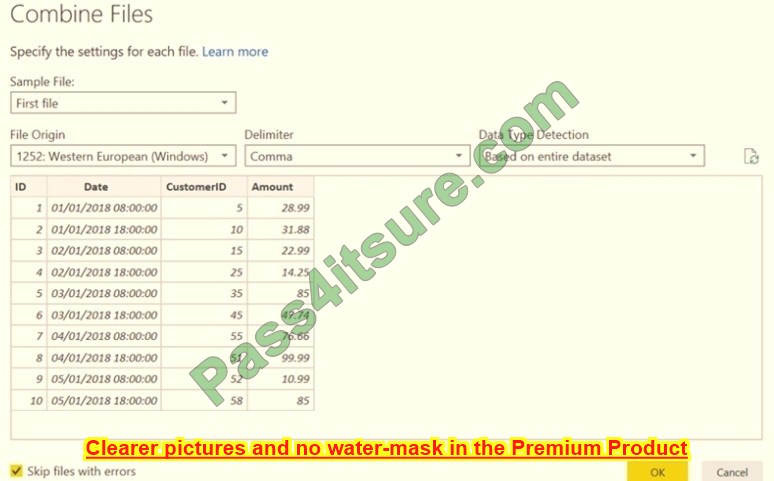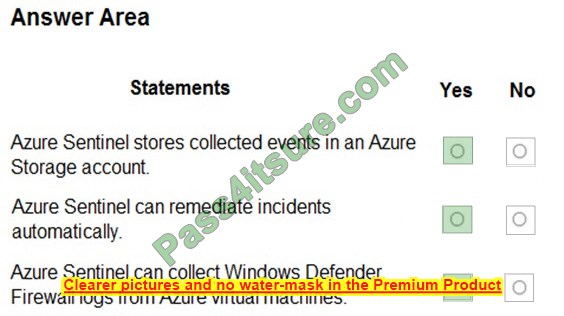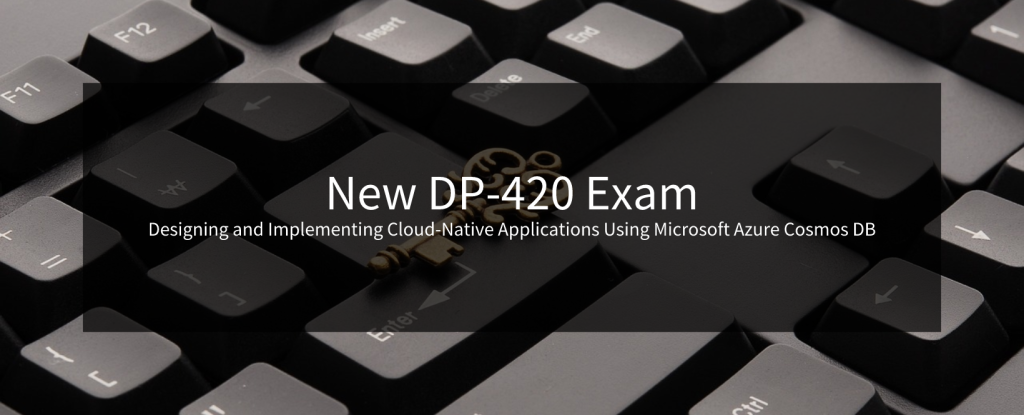
Preparing for the Microsoft Azure exam DP-420 can be a daunting challenge. Examrap will tell you that the new DP-420 dumps have solved this problem for you.
Pass4itSure understands the difficulties candidates face while preparing for the DP-420 exam. The new DP-420 dumps are provided to provide a valuable resource for exam preparation.
A comprehensive set of new and authentic DP-420 exam questions and answers ensures that you are fully prepared and confident for the Designing and Implementing Cloud-Native Applications Using Microsoft Azure Cosmos DB exam. Get new DP-420 dumps PDF or VCE now: https://www.pass4itsure.com/dp-420.html 117+ new DP-420 exam questions and answers.
To pass the Microsoft DP-420 exam, you should first understand what the exam is.
In short, the DP-420 Microsoft exams
The full name of the DP-420 exam is Designing and Implementing Cloud-Native Applications Using Microsoft Azure Cosmos DB, everyone likes to refer to it as the Azure DP-420 exam for short, the exam is 120 minutes, and the number of questions reaches 40-60.
A passing score of 700 points is required. Successfully passing the exam earns the Microsoft Certified: Azure Cosmos DB Developer Specialty.
Microsoft Azure DP-420 Change! This exam was updated on November 2nd, 2023, so the old exam questions are not applicable, and you will need the new DP-420 dumps question answers.
DP-420 Change! Please take a closer look
The table below is clearer, which is a comparison between the two versions of the test skills measure, and the third column describes the extent of the change.
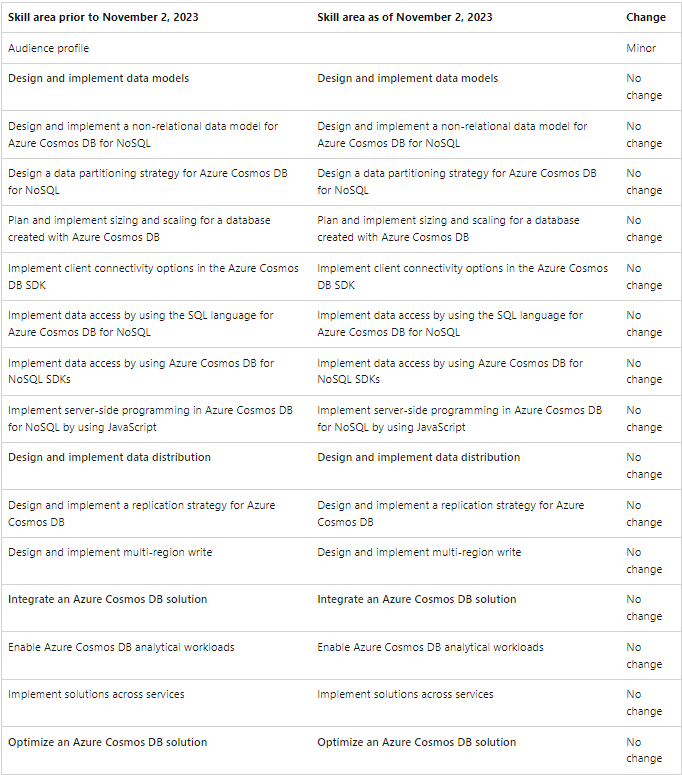
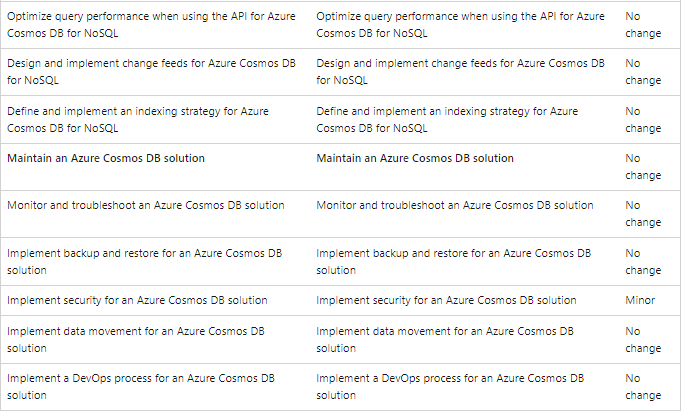
Exams are changing, and exam resources must be up-to-date to be valid.
Microsoft DP-420 exam additional resources, for convenience, are listed in a table:
| Study resources | Links to learning and documentation |
| Get community support | Analytics on Azure – Microsoft Tech Community Azure Data Factory – Microsoft Tech Community Azure – Microsoft Tech Community |
| Ask a question | Microsoft Q&A | Microsoft Docs |
If you want to read the DP-420 book, I recommend this one:
I think the writing is good, and it will help the exam.
Get back to business and share new DP-420 exam question answers, highlight key points, and do it for free!
Are you ready? Take a look at the new DP-420 dumps new exam question answers
Question 1:
You have a container named container1 in an Azure Cosmos DB Core (SQL) API account.
You need to provide a user named User1 with the ability to insert items into container1 by using role-based access control (RBAC). The solution must use the principle of least privilege.
Which roles should you assign to User1?
A. CosmosDB Operator only
B. DocumentDB Account Contributor and Cosmos DB Built-in Data Contributor
C. DocumentDB Account Contributor only
D. Cosmos DB Built-in Data Contributor only
Correct Answer: A
Cosmos DB Operator: Can provision Azure Cosmos accounts, databases, and containers. Cannot access any data or use Data Explorer. Incorrect Answers:
B: DocumentDB Account Contributor can manage Azure Cosmos DB accounts. Azure Cosmos DB was formerly known as DocumentDB.
C: DocumentDB Account Contributor: Can manage Azure Cosmos DB accounts.
Reference: https://docs.microsoft.com/en-us/azure/cosmos-db/role-based-access-control
Question 2:
You have an Azure Cosmos DB Core (SQL) API account that uses a custom conflict resolution policy. The account has a registered merge procedure that throws a runtime exception.
The runtime exception prevents conflicts from being resolved.
You need to use an Azure function to resolve the conflicts.
What should you use?
A. a function that pulls items from the conflicts feed and is triggered by a timer trigger
B. a function that receives items pushed from the change feed and is triggered by an Azure Cosmos DB trigger
C. a function that pulls items from the change feed and is triggered by a timer trigger
D. a function that receives items pushed from the conflicts feed and is triggered by an Azure Cosmos DB trigger
Correct Answer: D
The Azure Cosmos DB Trigger uses the Azure Cosmos DB Change Feed to listen for inserts and updates across partitions. The change feed publishes inserts and updates, not deletions.
Reference: https://docs.microsoft.com/en-us/azure/azure-functions/functions-bindings-cosmosdb
Question 3:
You have a container m an Azure Cosmos DB for a NoSQL account.
Data update volumes are unpredictable.
You need to process the change of the container by using a web app that has multiple instances. The change feed will be processed by using the change feed processor from the Azure Cosmos DB SDK. The multiple instances must share the workload.
Which three actions should you perform? Each correct answer presents part of the solution.
NOTE: Each correct selection is worth one point.
A. Configure the same processor name for all the instances.
B. Configure a different processor name for each instance.
C. Configure a different lease container configuration for each instance.
D. Configure the same instance name for all the instances. 13
E. Configure a different instance name for each instance.
F. Configure the same lease container configuration for all the instances.
Correct Answer: AEF
Question 4:
After you answer a question in this section, you will NOT be able to return to it. As a result, these questions will not appear in the review screen.
You have a container named container1 in an Azure Cosmos DB Core (SQL) API account.
You need to make the contents of container1 available as reference data for an Azure Stream Analytics job.
Solution: You create an Azure Synapse pipeline that uses Azure Cosmos DB Core (SQL) API as the input and Azure Blob Storage as the output.
Does this meet the goal?
A. Yes
B. No
Correct Answer: B
Instead, create an Azure function that uses Azure Cosmos DB Core (SQL) API change feed as a trigger and Azure event hub as the output.
The Azure Cosmos DB change feed is a mechanism to get a continuous and incremental feed of records from an Azure Cosmos container as those records are being created or modified. Change feed support works by listening to the container for any changes. It then outputs the sorted list of documents that were changed in the order in which they were modified.
Reference: https://docs.microsoft.com/en-us/azure/cosmos-db/sql/changefeed-ecommerce-solution
Question 5:
You have a global e-commerce application that stores data in an Azure Cosmos OB for a NoSQL account. The account is contoured for multi-region writes.
You need to create a stored procedure for a custom conflict resolution policy for a new container.
In the event of a conflict caused by a deletion, the deletion must always take priority.
Which parameter should you check m the stored procedure function?
A. conf1ictingItems
B. is Tombstone
C. existingitem
D. incoming1tem
Correct Answer: B
Question 6:
HOTSPOT
You have an Azure Cosmos DB Core (SQL) API account named account1 that has the disableKeyBasedMetadataWriteAccessproperty enabled.
You are developing an app named App1 that will be used by a user named DevUser1 to create containers in account1. DevUser1 has a non-privileged user account in the Azure Active Directory (Azure AD) tenant.
You need to ensure that DevUser1 can use App1 to create containers in account1.
What should you do? To answer, select the appropriate options in the answer area.
NOTE: Each correct selection is worth one point.
Hot Area:
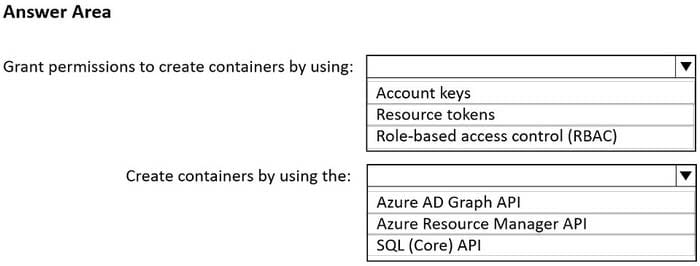
Correct Answer:
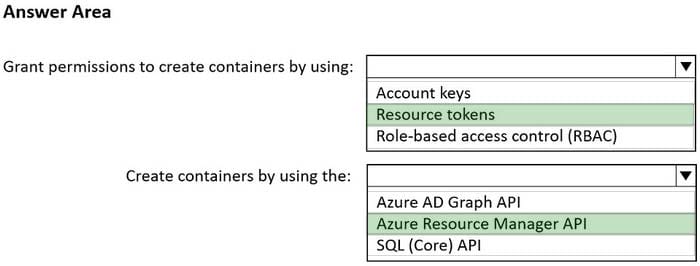
Box 1: Resource tokens
Resource tokens provide access to the application resources within a database. Resource tokens:
Provide access to specific containers, partition keys, documents, attachments, stored procedures, triggers, and UDFs.
Box 2: Azure Resource Manager API
You can use Azure Resource Manager to help deploy and manage your Azure Cosmos DB accounts, databases, and containers.
Incorrect Answers:
The Microsoft Graph API is a RESTful web API that enables you to access Microsoft Cloud service resources.
Reference:
https://docs.microsoft.com/en-us/azure/cosmos-db/secure-access-to-data
https://docs.microsoft.com/en-us/rest/api/resources/
Question 7:
After you answer a question in this section, you will NOT be able to return to it. As a result, these questions will not appear in the review screen.
You have a container named container1 in an Azure Cosmos DB Core (SQL) API account.
You need to make the contents of container1 available as reference data for an Azure Stream Analytics job.
Solution: You create an Azure Data Factory pipeline that uses Azure Cosmos DB Core (SQL) API as the input and Azure Blob Storage as the output.
Does this meet the goal?
A. Yes
B. No
Correct Answer: B
Instead, create an Azure function that uses Azure Cosmos DB Core (SQL) API change feed as a trigger and Azure event hub as the output.
The Azure Cosmos DB change feed is a mechanism to get a continuous and incremental feed of records from an Azure Cosmos container as those records are being created or modified. Change feed support works by listening to the container for any changes. It then outputs the sorted list of documents that were changed in the order in which they were modified.
Reference: https://docs.microsoft.com/en-us/azure/cosmos-db/sql/changefeed-ecommerce-solution
Question 8:
You have a database in an Azure Cosmos DB Core (SQL) API account. The database is backed up every two hours.
You need to implement a solution that supports point-in-time restore.
What should you do first?
A. Enable Continuous Backup for the account.
B. Configure the Backup and Restore settings for the account.
C. Create a new account that has a periodic backup policy.
D. Configure the Point In Time Restore settings for the account.
Correct Answer: A
When creating a new Azure Cosmos DB account, in the Backup policy tab, choose continuous mode to enable the point-in-time restore functionality for the new account. With the point-in-time restore, data is restored to a new account, currently, you can’t restore to an existing account.
Reference: https://docs.microsoft.com/en-us/azure/cosmos-db/provision-account-continuous-backup
Question 9:
After you answer a question in this section, you will NOT be able to return to it. As a result, these questions will not appear in the review screen.
You have an Azure Cosmos DB Core (SQL) API account named Account 1 that uses autoscale throughput.
You need to run an Azure function when the normalized request units per second for a container in account exceeds a specific value.
Solution: You configure the function to have an Azure CosmosDB trigger.
Does this meet the goal?
A. Yes
B. No
Correct Answer: B
Instead, configure an Azure Monitor alert to trigger the function.
You can set up alerts from the Azure Cosmos DB pane or the Azure Monitor service in the Azure portal.
Reference:
https://docs.microsoft.com/en-us/azure/cosmos-db/create-alerts
Question 10:
You configure multi-region writes for an account.
You need to ensure that App1 supports the new configuration for account1. The solution must meet the business requirements and the product catalog requirements.
What should you do?
A. Set the default consistency level of the account to bounded staleness.
B. Create a private endpoint connection.
C. Modify the connection policy of App1.
D. Increase the number of request units per second (RU/s) allocated to the con-product and con-productVendor containers.
Correct Answer: D
App1 queries the con-product and con-productVendor containers.
Note: Request unit is a performance currency abstracting the system resources such as CPU, IOPS, and memory that are required to perform the database operations supported by Azure Cosmos DB.
Scenario:
Develop an app named App1 that will run from all locations and query the data in account1.
Once multi-region writes are configured, maximize the performance of App1 queries against the data in the account.
Whenever there are multiple solutions for a requirement, select the solution that provides the best performance, as long as there are no additional costs associated.
Incorrect Answers:
A: Bounded staleness relates to writing. App1 only does reads.
Note: Bounded staleness is frequently chosen by globally distributed applications that expect low write latencies but require a total global order guarantee. Bounded staleness is great for applications featuring group collaboration and sharing, stock ticker, publish-subscribe/queueing, etc.
Reference: https://docs.microsoft.com/en-us/azure/cosmos-db/consistency-levels
Question 11:
The settings for a container in an Azure Cosmos DB Core (SQL) API account are configured as shown in the following exhibit.
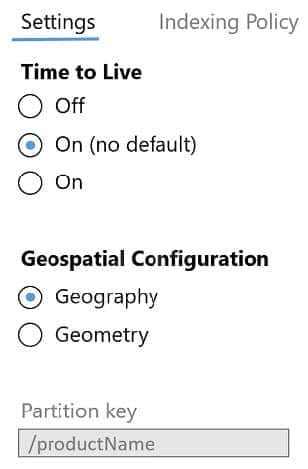
Which statement describes the configuration of the container?
A. All items will be deleted after one year.
B. Items stored in the collection will be retained always, regardless of the items’ time to live value.
C. Items stored in the collection will expire only if the item has time to live value.
D. All items will be deleted after one hour.
Correct Answer: C
When DefaultTimeToLive is -1 then your Time to Live setting is On (No default)
Time to Live on a container, if present and the value is set to “-1”, it is equal to infinity, and items don’t expire by default.
Time to Live on an item:
This Property is applicable only if DefaultTimeToLive is present and it is not set to null for the parent container.
If present, it overrides the DefaultTimeToLive value of the parent container.
Reference:
https://docs.microsoft.com/en-us/azure/cosmos-db/sql/time-to-live
Question 12:
You have a database in an Azure Cosmos DB for NoSQL account that is configured for multi-region writes.
You need to use the Azure Cosmos DB SDK to implement the conflict resolution policy for a container. The solution must ensure that any conflict is sent to the conflict feed.
Solution:
1. You set ConfilictResolutionMode to Custom.
2. You Set ResolutionProcedures to a custom stored procedure.
3. You configure the custom stored procedure to use the conflictingItems parameter to resolve conflict.
Does this meet the goal?
A. Yes
B. No
Correct Answer: A
Setting ConflictResolutionMode to Custom and configuring a custom stored procedure with the “conflictingItems” parameter will allow you to implement a custom conflict resolution policy. This will ensure that any conflicts are sent to the conflict feed for resolution.
Question 13:
You have a database in an Azure Cosmos DB for a NoSQL account that is configured for multi-region writes.
You need to use the Azure Cosmos DB SDK to implement the conflict resolution policy for a container. The solution must ensure that any conflict is sent to the conflict feed.
Solution: You set ConfilictResolutionMode to Custom and you use the default settings for the policy.
Does this meet the goal?
A. Yes
B. No
Correct Answer: B
Setting ConflictResolutionMode to Custom and using the default settings for the policy will not ensure that conflicts are sent to the conflict feed. You need to define a custom stored procedure using the “conflictingItems” parameter to handle conflicts properly.
Question 14:
You have the following query.
SELECT * FROM с WHERE c.sensor = “TEMP1” AND c.value < 22 AND c.timestamp >= 1619146031231
You need to recommend a composite index strategy that will minimize the request units (RUs) consumed by the query.
What should you recommend?
A. a composite index for (sensor ASC, value ASC) and a composite index for (sensor ASC, timestamp ASC)
B. a composite index for (sensor ASC, value ASC, timestamp ASC) and a composite index for (sensor DESC, value DESC, timestamp DESC)
C. a composite index for (value ASC, sensor ASC) and a composite index for (timestamp ASC, sensor ASC)
D. a composite index for (sensor ASC, value ASC, timestamp ASC)
Correct Answer: A
If a query has a filter with two or more properties, adding a composite index will improve performance.
Consider the following query:
SELECT * FROM c WHERE c.name = “Tim” and c.age > 18
In the absence of a composite index on (name ASC, and age ASC), we will utilize a range index for this query. We can improve the efficiency of this query by creating a composite index for name and age.
Queries with multiple equality filters and a maximum of one range filter (such as >,<, <=, >=, !=) will utilize the composite index.
Question 15:
After you answer a question in this section, you will NOT be able to return to it. As a result, these questions will not appear in the review screen.
You have a container named container1 in an Azure Cosmos DB Core (SQL) API account.
You need to make the contents of container1 available as reference data for an Azure Stream Analytics job.
Solution: You create an Azure function that uses Azure Cosmos DB Core (SQL) API change feed as a trigger and Azure event hub as the output.
Does this meet the goal?
A. Yes
B. No
Correct Answer: B
The Azure Cosmos DB change feed is a mechanism to get a continuous and incremental feed of records from an Azure Cosmos container as those records are being created or modified. Change feed support works by listening to the container for any changes. It then outputs the sorted list of documents that were changed in the order in which they were modified.
Reference: https://docs.microsoft.com/en-us/azure/cosmos-db/sql/changefeed-ecommerce-solution
| Come from | Number of exam questions | Other |
| Pass4itSure | 15/117 | Other Microsoft Certifications |
If that’s not enough, check out the video mode, which also brings you the latest exam questions:
Doubts about the exam, I’ll answer
Do I need to take any mandatory exams before DP-420 to complete DP-420?
Complete the DP-420 exam to earn the Microsoft Certified: Azure Cosmos DB Developer Specialty certification. The only exam required.
How to download updated DP-420 dumps PDF 2023?
You can go to the Pass4itSure website and search for the DP-420 page, you can download the latest DP-420 dumps PDF, free trial.
How do I pass the Microsoft DP-420 exam in a short time?
Prepare for the exam with the new DP-420 resources, and practice with new DP-420 exam questions to help you pass the Designing and Implementing Cloud-Native Applications Using Microsoft Azure Cosmos DB exam as quickly as possible.
One last word:
Preparing for the Microsoft DP-420 exam is a meaningful journey that opens the door to exciting career opportunities. Please consider using Pass4itSure’s new DP-420 exam question answers for effective exam preparation.
Pass4itSure’s new DP-420 dumps are designed to stay up-to-date with the latest exam content, ensuring that you cover all important topics and maximize your chances of success.
Come and download the new DP-420 dumps exam questions answers PDF or VCE https://www.pass4itsure.com/dp-420.html with the help of which you can easily pass the tough DP-420 exams.
